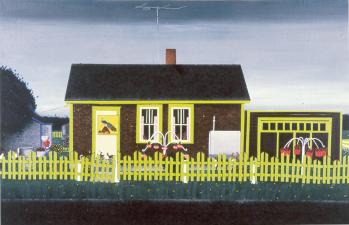
David Thauberger is renowned for his paintings of the vernacular architecture and cultural icons of Saskatchewan. Together with his paintings of popular culture and postcard images of tourist meccas far and wide, his images of Saskatchewan are clever debates involving art, culture, and how we view our world, presenting a hyper-real picture of our context that transcends regionalism while capturing the heart of what it means to be from Saskatchewan. His trademark geometric shapes, bright colours, flat surfaces and “special effects” contribute to paintings that are ironic and humourous, but also genuine and heartfelt. Thauberger experiments with the surfaces of his paintings, blending application techniques such as toothbrush “spatter” with flocking, glitter, rhinestones, and nails to create works that nevertheless present a unified if highly tactile surface.
David Thauberger was born in Holdfast. He studied ceramics at the University of Saskatchewan, Regina Campus, where “funk” artist David Gilhooly served as an early mentor, inspiring Thauberger and others to create art that was rooted in their own geographical region. He earned his BFA in 1971 and his MA in 1972 from California State University (Sacramento). He then studied with Rudy Autio at the University of Montana in Missoula, earning his MFA in 1973. In his ceramic work, Thauberger created complex and quirky tableaux that made use of a wide range of non-traditional materials - enamels, acrylics, crayons and wax - to create surface effects.
Back in Regina, he became increasingly engaged with surface effects and the formal aspects of flatness and frontality that painting offered and, with no formal training in the medium, turned to painting around 1974. Thauberger worked as a consultant for the Saskatchewan Arts Board (1974- 78, 1983-85) where he became aware of the work of many so-called “folk” artists in the province. At first, the work of William McCargar - followed by Wesley Dennis, Harvey McInnes, Molly Lenhardt, Sam Spencer and Jan Wyers - repulsed him, but he soon came to value their grassroots approach to making art and dealing with the prairies. He researched, purchased, and championed their work, curating exhibitions and contributing to documentaries, and in return learned important lessons about making art within a specific place. Having been included in a number of significant ceramic exhibitions in the early and mid-1970s, Thauberger began showing his paintings, most notably in David Thauberger: Prairie Pictures (Dunlop Art Gallery, 1979) and is the only painter included in the prestigious Pluralities 1980 (National Gallery of Canada, 1980). Since then, his work has been seen in numerous public exhibitions throughout Canada, has received national commercial success, and is included in collections across North America. Thauberger is a member of the Royal Canadian Academy of the Arts, and is the recipient of many awards and grants. He has been a visiting artist across the country and has served on the board of the Canada Council for the Arts.
Christine Sowiak
Print EntryHOME | BROWSE BY SUBJECT | ENTRY LIST (A-Z) | IMAGE INDEX | CONTRIBUTOR INDEX | ABOUT THE ENCYCLOPEDIA | SPONSORS TERMS OF USE | COPYRIGHT © 2006 CANADIAN PLAINS RESEARCH CENTER, UNIVERSITY OF REGINA | POWERED BY MERCURY CMS |
|||
| This web site was produced with financial assistance provided by Western Economic Diversification Canada and the Government of Saskatchewan. |
|||
 |
 |
 |
 |
| Ce site Web a été conçu grâce à l'aide financière de Diversification de l'économie de l'Ouest Canada et le gouvernement de la Saskatchewan. |
|||